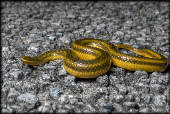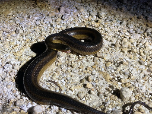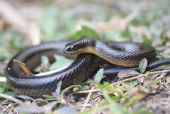Striped Swamp Snake (Liodytes alleni)
Description: The Striped Swampa Snake or striped crayfish snake is of "small medium" size, 13 to 20 inches in total length (including tail), with a heavy body. The stripes which contribute to its common name are indistinct and located on the dark dorsal side. The ventral side is yellow with some dark spots. The dorsal scales, which are arranged in 19 rows at midbody, are smooth on the body, with some keeled scales in the anal region. There is a clear sexual dimorphism with the females being the larger sex. The striped crayfish snake is very similar to the glossy crayfish snake (Liodytes rigida rigida), but has one row of spots on the underside, whereas the glossy crayfish snake has two spots.
Habitat: The striped crayfish snake is a semiaquatic snake and is regularly found in swamps and open wetlands with heavy plant growth, cypress swamps, saw grass prairies, swamps, and roadside ditches. The snake has adapted well to the beds of water hyacinth that has taken over many waterways. Although the species is aquatic, it is rarely seen in moving water.
Range: The snake is primarily found in Florida. It is commonly found east of the central panhandle and in southeastern Georgia. The northern range limit is near the Florida-Georgia border.
Found in these States:
FL |
GA
Diet: The striped crayfish snake feeds primarily on crayfish. It uses its coils to hold its prey while consuming it alive. Its teeth are small and very sharp, allowing it to grab and hold the hard outer covering of the crayfish. It typically swallows the crustacean tail first. Juveniles feed on insect larvae, most commonly the larvae of dragonflies and shrimp.
Reproduction: There is very little known about the reproduction of the striped crayfish snake. Adults probably mate during the spring season, and the young are born alive during the late summer or autumn. Brood size is from four to twelve neonates. Larger snakes usually produce more young than smaller snakes.
Status: Listed as Least Concern in view of its wide distribution, tolerance of a degree of habitat modification, presumed large population, and because it is unlikely to be declining fast enough to qualify for listing in a more threatened category.
»» Kingdom: Animalia - Animals
»» Phylum: Chordata - Chordates
»» Subphylum: Vertebrata - Vertebrates
»» Class: Reptilia - Reptiles
»» Order: Squamata - Scaled Reptiles
»» Suborder: Serpentes
»» Superfamily: Colubroidea
»» Family: Colubridae - Colubrids
»» Genus: Liodytes
»» Species: Liodytes alleni - Striped Swamp Snake
This article uses material from the Wikipedia article "Striped crayfish snake", which is released under the Creative Commons Attribution-Share-Alike License 3.0. Content may have been omitted from the original, but no content has been changed or extended.
|













